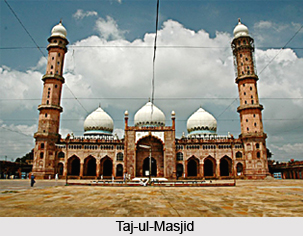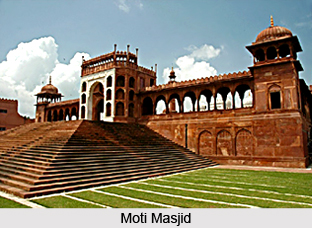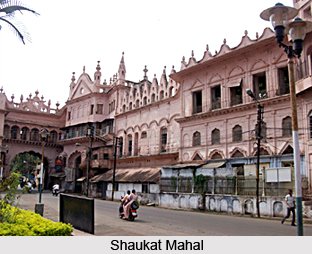 Bhopal is the capital of Madhya Pradesh, a large sprawling city. The city, which is enclosed by a masonry wall, stands on the north bank of a large lake. The name of the city is alleged to derive from Raja Bhoj, who is supposed to have created the surrounding lakes by building a dam or pal, hence Bhojpal. The city was laid out by the founder of the dynasty, Dost Muhammad, an Afghan in the service of Aurangzeb.
Bhopal is the capital of Madhya Pradesh, a large sprawling city. The city, which is enclosed by a masonry wall, stands on the north bank of a large lake. The name of the city is alleged to derive from Raja Bhoj, who is supposed to have created the surrounding lakes by building a dam or pal, hence Bhojpal. The city was laid out by the founder of the dynasty, Dost Muhammad, an Afghan in the service of Aurangzeb.
Some of the notable architectural structures of Bhopal are namely the Moti Masjid, the Palace of the Nawab, the Jama Masjid, Gardens of Qudsia and a lot more.
The Palace of the Nawab is a large, impressive building with sheer walls rising from the lake. To the south-west, on a large rock, is Fatehgarh, a fort from which excellent views can be obtained across the lake. Within the fort is an armoury.
 The Jama Masjid built by Qudsia Begum, stands in the bazaar. The mosque was built in the year 1837. The special architectural feature of the mosque is that gold spikes crown the minaret of the mosque. The Moti Masjid was built by Qudsia Begum`s daughter, Sikander Jahan Begum in the year 1860. It is similar in style to the Jama Masjid in Delhi, with two tall red minarets capped with gilt finials. In fact Moti Masjid of Bhopal is an important landmark of Bhopal. It is one of the largest mosques in India, a huge pink structure with two colossal white-domed minarets and three bulbous domes, a striking local landmark visible for miles around. The fa‡ade of the mosque is marble-white with two small cupolas atop it, and it has two huge black minarets on either side of it.
The Jama Masjid built by Qudsia Begum, stands in the bazaar. The mosque was built in the year 1837. The special architectural feature of the mosque is that gold spikes crown the minaret of the mosque. The Moti Masjid was built by Qudsia Begum`s daughter, Sikander Jahan Begum in the year 1860. It is similar in style to the Jama Masjid in Delhi, with two tall red minarets capped with gilt finials. In fact Moti Masjid of Bhopal is an important landmark of Bhopal. It is one of the largest mosques in India, a huge pink structure with two colossal white-domed minarets and three bulbous domes, a striking local landmark visible for miles around. The fa‡ade of the mosque is marble-white with two small cupolas atop it, and it has two huge black minarets on either side of it.
The most impressive structure is the Taj-ul Masjid, commenced by Shah Jahan Begum in the late 19th century. This mosque of Bhopal is in fact the largest mosque of the country. It is a pink structure with two white minarets and three white domes in the main structure.
The Chowk which lies to the heart of the city is a witness to the princely style of the bygone days. The chowk is lined with temples, palaces, havelis and other architectural splendours of the yester years.
 Shaukat Mahal and Sadar Manzil are also situated in the heart of the city. It is said that these two structures are points of architectural curiosity. Shaukat Mahal is an architectural curiosity because its architecture has abundant touch of the occidental style making it different from the other architectural constructions of the city which reflect the Islamic style closely.
Shaukat Mahal and Sadar Manzil are also situated in the heart of the city. It is said that these two structures are points of architectural curiosity. Shaukat Mahal is an architectural curiosity because its architecture has abundant touch of the occidental style making it different from the other architectural constructions of the city which reflect the Islamic style closely.
The Lakshmi Narayan Temple in the city of Bhopal is an example of Hindu architecture. The temple has been dedicated to Lord Vishnu and Lord Shiva and their respective consorts. In the temple the sculptures which are found dates back to the Paramana period and the terracotta architecture which is found in the temple reflects the spirit of the Kausambi era.
Other buildings worth a visit are the Mint, the Arsenal and the Gardens of Qudsia and Sikander Begum. The Alexandra High School for Boys is in the old Benazir Palace; the Sultania Girls` School is not to be outdone in terms of perfection in its construction. It is located in the Taj Mahal Palace. The Lady Landsdowne Hospital should also be noted for its meticulous architecture.
It can be summed up that the architecture of Bhopal is predominantly a reflection of the Islamic style of art and at the same time the architectural pieces of Bhopal are carrying their glory from times immemorial.



















